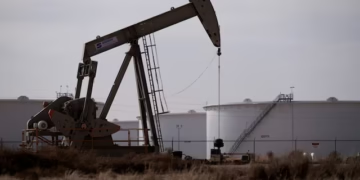Oil Prices Plunge to Four-Year Lows Amid U.S.-China Tariff Escalation and Rising Supply Outlook
April 9, SINGAPORE/BEIJING (Reuters) – Global crude oil prices tumbled to their lowest levels in over four years on Wednesday, as escalating trade tensions between the United States and China—coupled with a projected increase in oil supply—sparked renewed concerns over weakening demand.
Brent crude futures declined by $2.38, or 3.79%, to $60.44 per barrel as of 04:23 GMT, while U.S. West Texas Intermediate (WTI) crude futures dropped $2.46, or 4.13%, to $57.12. Both benchmarks touched their lowest levels since February 2021.
The six-month Brent futures spread narrowed to 79 cents, its lowest point since mid-November, signaling a potential market surplus. The spread has contracted significantly—down 86% from a peak of $5.69 on January 15, which previously reflected tighter supply and expectations of a Chinese demand rebound.
This recent decline marks the fifth consecutive session of losses, following U.S. President Donald Trump’s announcement of sweeping new tariffs on Chinese imports. The new 104% tariff rate came into effect at 12:01 a.m. EDT on Wednesday, after Beijing failed to remove its 34% retaliatory tariffs by a Tuesday noon deadline. In response, China vowed not to yield to what it described as “U.S. blackmail.”
“China’s aggressive retaliation diminishes the prospects of a swift resolution between the world’s two largest economies, heightening fears of a global economic slowdown,” said Ye Lin, Vice President of Oil Commodity Markets at Rystad Energy. She added that the ongoing trade conflict could threaten between 50,000 and 100,000 barrels per day (bpd) of Chinese oil demand growth, though domestic stimulus measures could help offset the impact.
Contributing to bearish sentiment was last week’s announcement by OPEC+—which includes OPEC members and allies such as Russia—to increase output by 411,000 bpd starting in May. Analysts say the move could further tip the market into oversupply.
Goldman Sachs has subsequently revised its forecasts, projecting Brent and WTI prices could fall to $62 and $58 per barrel, respectively, by December 2025, and further down to $55 and $51 by December 2026.
Adding to the pressure, Russia’s ESPO Blend crude dropped below the $60 per barrel Western price cap for the first time on Monday.
In a modestly positive development, data from the American Petroleum Institute showed U.S. crude inventories declined by 1.1 million barrels for the week ending April 4, defying Reuters poll expectations for a build of 1.4 million barrels. Official inventory figures from the U.S. Energy Information Administration are expected later today at 10:30 a.m. EDT.
Also Read : Sensex Falls 450 Points, Nifty Slips Below 22,400 Amid Tariff Concerns and RBI Policy Impact















 Categories
Categories










